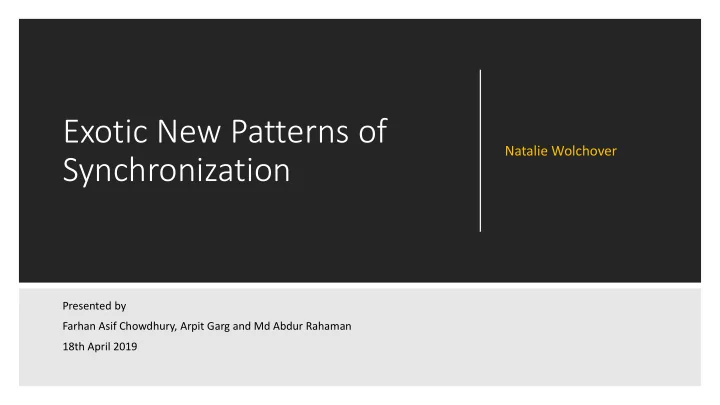

Exotic New Patterns of Natalie Wolchover Synchronization Presented by Farhan Asif Chowdhury, Arpit Garg and Md Abdur Rahaman 18th April 2019
Synchronization • Two or more dynamical systems • Adjust some of their properties • To a common behavior • Due to strong or weak coupling.
Synchronization in Nature • Fireflies sync their flashes • Crickets sing in sync • Neurons in our brain fire in sync • Pacemaker cell sync up their beat Male fireflies synchronizing their flashes
Exploring Synchronization: An Early Experiment • The pendulums swung in unison. • They go towards each other and then away. • Reason: They exerted force on each other via the wall. • They sync to attain their most “stable” and “relaxed” state. A pair of pendulum hanging from wall
Exploring Synchronization: New Patterns Global Synchronization: Chimera State: Some oscillate in sync, A population of oscillators all some drift incoherently. do the same thing.
Synchronization in Network • Not all oscillators are connected to each other. Has some specific set of connection. • Better model for real world systems: Brain and Internet. Cluster Sync: The network breaks up into clusters of oscillators that sync.
Synchronization in Network (II) Remote Sync: Oscillators not directly linked sync up as a cluster, but oscillators in between behave differently. • Scientists have observed remote sync with "Chimera" state. • Relevant for neuronal information processing. Chaotic Sync: Individually unpredictable oscillators sync and evolve together.
Synchronization: Experiments using NEM Splay State Traveling wave state Noise driven chimera
Why Study Synchronization A major motivation: Our human brain is a network of neurons acting in a combination of synchrony as well as synchrony. • How human brain works? • Functionality and interaction of different parts • Brain disease: Similarities between the destabilization of chimera states and epileptic seizure.
Inter-Brain Synchronization during Social Interaction Dumas G, et al. (2010) PLoS One Journal
• When two people talk Interactional • Volume and pitch come in to balance Synchrony • Speech rate and latency equalizes
Purpose
Experimental Setting
Spontaneous Imitation (SI) Two Tasks Induced Imitation (II)
Video Recordings • Labeled by either of the following labels: Sync, NSync, Im, NIm Two Types of EEG Data Data • PLV for each pair of electrodes b/w the two helmets • If PLV = 1; same phase • If PLV = 0; totally non synced
Results Major Findings • Interactional synchrony is a consequence of inter brain neural sync. • centroparietal domains as the major functional hub during interactional synchrony • Neural synchronization became asymmetrical in the higher frequency bands Figures presented to back up those claims • Overall time spend by all the subjects • Comparison between different frequency bands • PLV differences between sync and non-sync interactions
Mean (and SD) percent time spent synchronizing and/or imitating hand movement during spontaneous imitation condition.
Right Centro- Where is this parietal regions synchrony coming from? Central and right parieto- occipital Centro- parietal and parieto-occipital
Time course of channel P8 Phase PLV for alpha-meu and beta band Time course for channel PO2 Phase PLV for alpha-meu and beta band Clo losely Looking in into the parie ietal region: Correspondence between interactional synchrony and brain activities for two given channels (P8 & PO2)
Summary of relevant inter-subject synchronizations for all dyads according to interactional synchrony 32- pair of active electrodes
Discussion • First study of dual-EEG activity • Behavioral synchrony is a result of inter brain synchronization • Evident to centroparietal regions as a functional hub of social interactions. • Comparison between different frequency bands gives an impression of how brain synchronization evolves across different frequency ranges. Criticisms • Very small dataset • All participants are from same age cohort (mean = 24.5).So, a synchrony in social interactions is already expected.
Thank You! Questions?
Why this synchronization is important? • A key mechanism for information integration • Temporal binding • Information propagation inside the brain • Prediction • Patient-control group differences.
Averaged inter-subject clustered PLV (cPLV) difference between synchronous and non-synchronous interactions (Sync - NSync) compared for experimental and surrogate behavioral analysis. Bars represent standard errors.
Recommend
More recommend